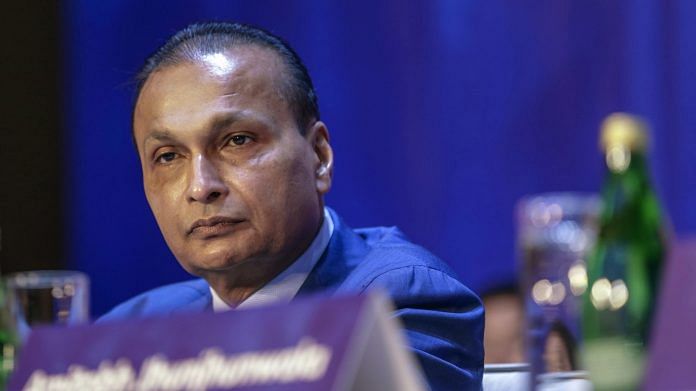The crisis of confidence that erupted in India’s shadow banking industry in 2018 has claimed its most high-profile casualty yet. In a surprise announcement Monday evening, the central bank said that it had superseded the board of a financier controlled by Anil Ambani, the younger brother of India’s richest man, appointed an administrator, and would soon be sending the firm to the bankruptcy tribunal.
The unraveling of Reliance Capital Ltd. shows why the Reserve Bank of India remains reluctant to allow big business groups into mom-and-pop banking, despite facing huge pressure to allow a wave of corporate capital into the industry and reignite credit growth. The financiers’ potential to do harm is lethal even without access to insured deposits.
More superficially, this is a story of two siblings and their dramatic divergence of fortunes. As Reliance Capital was being sent to the chopping block, Mukesh Ambani’s Reliance Industries Ltd. was in the news for different reasons. Shares of BT Group Plc jumped as much as 9.5% in London after the Economic Times reported that the Indian tycoon was considering an unsolicited bid for Britain’s largest phone company. Reliance said the article was “completely speculative.”
Anil Ambani’s misery couldn’t be more real, though. Creditors, including the government, are scrambling to recover the Rs 75,800 crore ($10 billion) owed to them by Reliance Communications Ltd., which shuttered its mobile service four years ago. Last year, the 62-year-old former billionaire was ordered by a London judge to pay more than $700 million to a trio of Chinese banks that had lent money to RCom against personal guarantees by Ambani. Reliance Naval & Engineering Ltd., which had a contract to build patrolling vessels for the Indian Navy, is also in insolvency. Creditors are looking at 80%-90% haircuts, BloombergQuint reported in September.
Now that Reliance Capital joins his other group businesses in the bankruptcy slaughterhouse, investors will get a clearer assessment of why their firm, which was once worth more than $3 billion, is most likely headed for a complete wipeout of the $64 million in shareholder value that still remains. The “serious governance concerns,” which the Reserve Bank of India says the board failed to address effectively, need to come out in the open. That won’t improve the outcome for Reliance Capital shareholders, but it will hopefully prevent similar blowups in the future.
It will also inform the debate on whether large business houses can be trusted with banking licenses. “It has always been our ambition to create a world-class bank,” Anil Ambani said at the annual general meeting of Reliance Capital back in 2010, when the RBI had just floated a discussion paper on allowing some new lenders into the system. Luckily, those ambitions never received regulatory blessings. Otherwise, the RBI today might be grappling with the far messier task of making individual depositors whole.
Not that the resolution of Reliance Capital is going to be a cakewalk. With nearly $9 billion in assets, according to the financier’s latest annual report, meeting a $2.9 billion liability to creditors at the end of October shouldn’t have been this hard. But for more than two years now, various orders by courts and debt recovery tribunals have prevented the company from disposing off assets. Creditors who tried to sell units got many expressions of interest. Still, no deal could fructify because of layers of litigation, the Business Standard reported earlier this month.
Reliance Capital joins a long list of Indian shadow banks that have keeled over since the sudden collapse of infrastructure financier IL&FS Group in September 2018. Dewan Housing Finance Corp. got sold to Indian billionaire Ajay Piramal. Srei Infrastructure Finance Ltd. and Srei Equipment Finance Ltd. were taken over by the RBI last month and are going to be put through the bankruptcy tribunal.
Formal bankruptcy isn’t an option for failed deposit-taking institutions, which are being resolved through shotgun marriages. State Bank of India was prevailed upon to do national service by rescuing Yes Bank Ltd. While the major corporate lender continues to exist independently, much smaller Lakshmi Vilas Bank Ltd. was allowed to die, with its depositors bailed out by Singapore’s DBS Group Holdings Ltd. The scam-tainted Punjab & Maharashtra Co-operative Bank got swallowed up by a fintech-financier consortium, though some of its depositors will get their money only in 10 years.
The RBI has done well not to succumb to the temptation of opening the floodgates of banking to large industrial houses, as recommended last year by an internal working group. It will take far greater supervisory skills than the Indian regulator can muster to keep on top of “connected lending” between banks and nonbank business interests of controlling shareholders, especially if they happen to be politically influential.
Anil Ambani’s misadventure is a cautionary tale. Reliance Capital’s unpaid creditors are debenture holders. Had Ambani received the go-ahead to set up his world-class bank, they would have been savings and current account customers. How many small savers can the RBI ask to wait for a decade for their money’s return before they lose all faith in the Indian banking system — and jump for Bitcoin and Tether?—Bloomberg
Also read: RBI supersedes board of Anil Ambani’s Reliance Capital over defaults in payment






